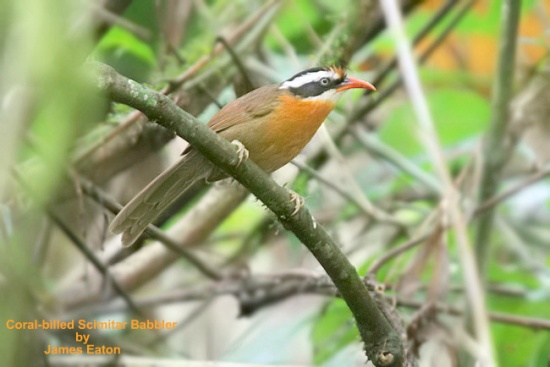- Pomatorhinus ferruginosus
Identification
24 cm (9½ in). A largish Scimitar Babbler.
- Rather short, thick red bill
- Black mask with white supercilium
- Crown all black
- Buff to dark rufous lower throat, breast and belly
- Upperparts greyish-brown
Sexes similar, juveniles are more rufescent above and below.
Confusion species
Red-billed Scimitar-Babbler has a thinner, longer and paler bill. It also lacks the black crown.
Distribution
Asia: Himalayas (eastern Nepal to eastern Assam (India) north of the Brahmaputra).
Taxonomy
This is a monotypic species[1].
Brown-crowned Scimitar Babbler was formerly included in this species.
Habitat
Broadleaf evergreen forest, bamboo, secondary growth or wild banana groves in gulleys. Found at 400 - 2400 m in the Indian Subcontinent.
Behaviour
Diet
Feeds on insects and their larvae. Reported to peel of and eat thin stripes of bamboo.
Very elusive and hard to see. Usually in pairs or small groups. Often on ground, reluctant to fly.
Breeding
Breeding season from April to August. The nest is an oval or bulky cone made of dry bamboo, rattan, grasses, plant fibres, stems and other material. It's placed on the ground or low down in a bush, sapling or bamboo clump. Lays 3 - 5 eggs.
Movements
Resident species.
References
- Clements, J. F., T. S. Schulenberg, M. J. Iliff, T. A. Fredericks, J. A. Gerbracht, D. Lepage, S. M. Billerman, B. L. Sullivan, and C. L. Wood. 2022. The eBird/Clements checklist of Birds of the World: v2022. Downloaded from https://www.birds.cornell.edu/clementschecklist/download/
- Gill, F, D Donsker, and P Rasmussen (Eds). 2023. IOC World Bird List (v 13.1)_red. Doi 10.14344/IOC.ML.13.1. http://www.worldbirdnames.org/
- Del Hoyo, J, A Elliott, and D Christie, eds. 2007. Handbook of the Birds of the World. Volume 12: Picathartes to Tits and Chickadees. Barcelona: Lynx Edicions. ISBN 978-8496553422
- Rasmussen, PC and JC Anderton. 2005. Birds of South Asia: The Ripley Guide. Barcelona: Lynx Edicions. ISBN 978-8487334672
- Avibase
Recommended Citation
- BirdForum Opus contributors. (2025) Black-crowned Scimitar Babbler. In: BirdForum, the forum for wild birds and birding. Retrieved 11 May 2025 from https://www.birdforum.net/opus/Black-crowned_Scimitar_Babbler
External Links
GSearch checked for 2020 platform.1




